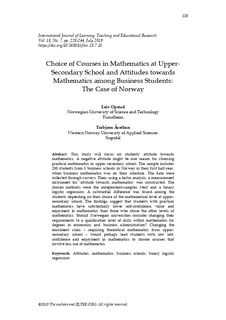| dc.contributor.author | Opstad, Leiv Trygve | |
| dc.contributor.author | Årethun, Torbjørn | |
| dc.date.accessioned | 2019-09-17T08:56:32Z | |
| dc.date.available | 2019-09-17T08:56:32Z | |
| dc.date.created | 2019-09-01T19:47:14Z | |
| dc.date.issued | 2019 | |
| dc.identifier.citation | International Journal of Learning, Teaching and Educational Research. 2019, 18 (7), 228-244. | nb_NO |
| dc.identifier.issn | 1694-2116 | |
| dc.identifier.uri | http://hdl.handle.net/11250/2617153 | |
| dc.description.abstract | This study will focus on students’ attitude towards mathematics. A negative attitude might be one reason for choosing practical mathematics in upper secondary school. The sample includes 230 students from 3 business schools in Norway in their first half-year, when business mathematics was on their schedule. The data were collected through surveys. Then, using a factor analysis, a measurement instrument for ‘attitude towards mathematics’ was constructed. The chosen methods were the independent-samples t-test and a binary logistic regression. A substantial difference was found among the students depending on their choice of the mathematical level at uppersecondary school. The findings suggest that students with practical mathematics have substantially lower self-confidence, value and enjoyment in mathematics than those who chose the other levels of mathematics. Should Norwegian universities consider changing their requirements to a qualification level of skills within mathematics for degrees in economics and business administration? Changing the enrolment rules – requiring theoretical mathematics from uppersecondary school – would perhaps lead students with low selfconfidence and enjoyment in mathematics to choose courses that involve less use of mathematics. | nb_NO |
| dc.language.iso | eng | nb_NO |
| dc.publisher | Tresorix Ltd | nb_NO |
| dc.title | Choice of Courses in Mathematics at Upper-Secondary School and Attitudes towards Mathematics among Business Students. The case of Norway | nb_NO |
| dc.type | Journal article | nb_NO |
| dc.type | Peer reviewed | nb_NO |
| dc.description.version | publishedVersion | nb_NO |
| dc.source.pagenumber | 228-244 | nb_NO |
| dc.source.volume | 18 | nb_NO |
| dc.source.journal | International Journal of Learning, Teaching and Educational Research | nb_NO |
| dc.source.issue | 7 | nb_NO |
| dc.identifier.doi | 10.26803/iijlter.18.7.15 | |
| dc.identifier.cristin | 1720410 | |
| dc.description.localcode | ©2019 The authors and IJLTER.ORG | nb_NO |
| cristin.unitcode | 194,60,10,0 | |
| cristin.unitname | NTNU Handelshøyskolen | |
| cristin.ispublished | true | |
| cristin.fulltext | original | |
| cristin.qualitycode | 1 | |
